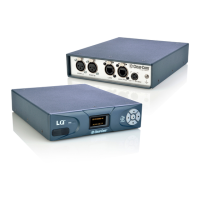
Do you have a question about the Clear-Com LQ series and is the answer not in the manual?
| Brand | Clear-Com |
|---|---|
| Model | LQ series |
| Category | Recording Equipment |
| Language | English |
Describes the different LQ and LQ-R models, their features, and specifications.
Illustrates fundamental network setups and common use cases for LQ devices.
Explains how to create and manage interconnected groups of LQ devices for networked audio.
Demonstrates a complex network scenario involving partyline and 4-wire connections.
Guides through preparing the necessary equipment and network for initial LQ device setup.
Details how to connect to and log into the CCM interface for device management.
Explains the process of establishing a Link-Group by defining device roles.
Describes how to map physical device ports to virtual partyline channels.
Explains how to connect and use the provided power supply units for LQ devices.
Details powering LQ devices via PoE and potential power capacity limitations.
Provides instructions for rebooting the LQ device using its front panel controls.
Lists the software and browser requirements for utilizing the CCM interface.
Describes the CCM's Overview screen for monitoring and managing linked LQ devices.
Covers direct and proxy configuration methods for managing devices in a Link-Group.
Outlines functions available on the General page, including renaming and maintenance.
Defines a Link-Group and its characteristics, including device limits and mesh networking.
Explains the primary responsibilities of the Link-Master in managing configuration and availability.
Lists administrative functions accessible directly from the LQ unit's front panel menu.
Details the audio configuration parameters adjustable on the front panel for ports.
Covers front panel settings related to device display, brightness, and screensaver.
Describes how to view network status, IP, and MAC addresses on the front panel.
Discusses the need for static external IP addresses for stable internet connectivity.
Explains the process of mapping firewall ports to enable internet access to LQ units.
Defines link-local IP addresses and explains when units enter this automatic network mode.
Guides on how to access the CCM when units are using link-local IP addresses.
Explains DHCP as the default method for automatic IP address assignment.
Details how to manually configure static IP addresses for LQ devices.
Discusses optimizing port settings for network and audio performance.
Explains how call signaling and RMK functionalities are handled by LQ ports.
Details specific settings for configuring 2-wire ports, including power and termination.
Explains the concept of virtual partyline channels and their configuration within Link-Groups.
Guides on setting up point-to-point 4-wire connections between ports.
Provides guidelines for connecting 2-wire intercom devices like beltpacks to LQ units.
Details pin-out configuration for interfacing LQ units with 4-wire devices.
Step-by-step guide for uploading firmware updates to LQ units via the CCM.
Explains methods to locate a unit's network identity using the front panel or GUI.
Clarifies that a solid red status light indicates loss of IP connection to the Link-Master.
Explains that a flashing red light signifies an ID conflict within the LQ-Group.
Lists audio performance specifications, including frequency response and codec details.
Provides pin-out details for Clear-Com and RTS 2-wire connections.